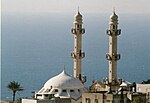Battle of Haifa (1948)
April 1948 eventsBattles and operations of the 1948 Arab–Israeli WarHistory of HaifaWikipedia extended-confirmed-protected pages

The Battle of Haifa, called by the Jewish forces Operation Bi'ur Hametz (Hebrew: מבצע ביעור חמץ "Passover Cleaning"), was a Haganah operation carried out on 21–22 April 1948 and was a major event in the final stages of the civil war in Palestine, leading up to the 1948 Arab-Israeli War. The objective of the operation was the capture of the Arab neighborhoods of Haifa.
Excerpt from the Wikipedia article Battle of Haifa (1948) (License: CC BY-SA 3.0, Authors, Images).Battle of Haifa (1948)
Med. Zekharya, Haifa Ramat Hatishbi
Geographical coordinates (GPS) Address Nearby Places Show on map
Geographical coordinates (GPS)
| Latitude | Longitude |
|---|---|
| N 32.815513888889 ° | E 34.975213888889 ° |
Address
מד' זכריה
Med. Zekharya
3551319 Haifa, Ramat Hatishbi
Haifa District, Israel
Open on Google Maps







